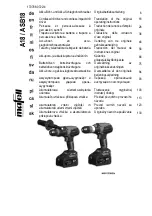
1. Brush all interior surfaces including grills and grates with vegetable cooking oil.
2. Build a small fire on the fire grate, being sure not to lay coals against the walls.
3. Close door. (Position butterfly damper and smokestack damper approximately at one quarter open.) This burn
should be sustained for at least two hours, the longer the better. Then, begin increasing temperature by opening the
butterfly damper and smokestack damper half-way and adding more charcoal. Your Smoker is now ready for
use.
Rust can appear on the inside of your smoker. Maintaining a light coat of vegetable oil on interior surfaces will aid in the
protection of your unit. Exterior surfaces of smoker may need occasional touch up. We recommend the use of a
commercially available black high temperature spray paint. NEVER PAINT THE INTERIOR OF THE UNIT !
GRILLING
Wood is recommended, however charcoal or a combination of both may be used as the fuel source for grilling, with the
fuel source placed and ignited on the fire grate. Do not build too large of a fire. We recommend starting a fire with no
more than 2 pounds of charcoal (approximately 25-30 briquettes) and adding more as needed during cooking. After allowing
the fire to burn down, place the cooking grills in the smoker. Failure to read and follow instructions for lighting charcoal
may result in serious personal injury and/or property damage.
SMOKING AND SLOW COOKING
foods.
the interior steel. Failure to properly follow these steps may damage the finish and/or impart metallic flavors to your first
Before cooking with your Smoker, the following steps should be closely followed to both cure the finish and season
Preparing and Using Your Smoker
Grilling with Wood Chips/Wood Chunks
For a more robust smoke flavor while using charcoal briquettes or lump charcoal, try adding wood chips or several wood chunks to
the fire. Wood chunks are available in a variety of natural flavors, and can be used alone or in addition to charcoal. As a general
rule, any hardwood that bears a fruit or nut is suitable for cooking. However, different woods have very different tastes. Experiment
with different woods to determine your personal favorite, and always use well-seasoned wood. Green or fresh-cut wood can turn
food black, and tastes bitter.
Our Recommendations:
Chicken
- Alder, Apple, Hickory, Mesquite, Sassafras
Beef
- Hickory, Mesquite, Oak, Grapevines
Pork
- Fruitwoods, Hickory, Oak, Sassafras
Lamb
- Fruitwoods, Mesquite
Veal
- Fruitwoods, Grapevines
Seafood
- Alder, Mesquite, Sassafras, Grapevines
Vegetables
– Mesquite
Page 3
If using the Smoker as a smoker or slow cooker, remove the cooking grill from the firebox and build your fire on top of the fire
grate in the firebox. Either charcoal or wood may be used, but wood is the recommended fuel for it’s rate of burn and the flavor
it imparts to the food being cooked. Most seasoned hardwoods are good for smoking such as hickory, mesquite, pecan, oak,
and many other fruit woods. Bark should be avoided or burned off first as it contains a high acid content and imparts an acrid
flavor.
After allowing the fire to burn down, close the doors and control the temperature and smoke with the dampers located on
the firebox and atop the smokestack. Smoke is contained within the chambers, which will reduce burn while imparting
more smoke flavor. Do not operate the Smoker with temperatures exceeding 450 degrees in the smoker chamber.
Place the food in the smoker chamber and monitor the temperature. Cooking and smoking are taking place using indirect
heat. There is no need to worry about a grease fire flare-up ruining the food. Do not place food within 6” of the opening
from the firebox into the smoker chamber. A general rule of thumb for cooking is about 1 hour per pound for smoking
large cuts of meat. Refer to a cook book for specific cuts of meats. Limit the number of times you open the smoker
chamber door as this will allow heat to escape and extend the cooking time.


































